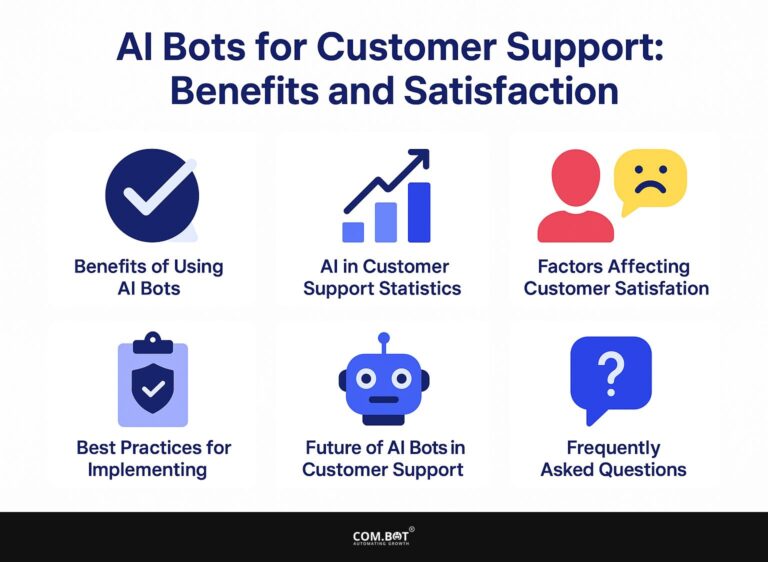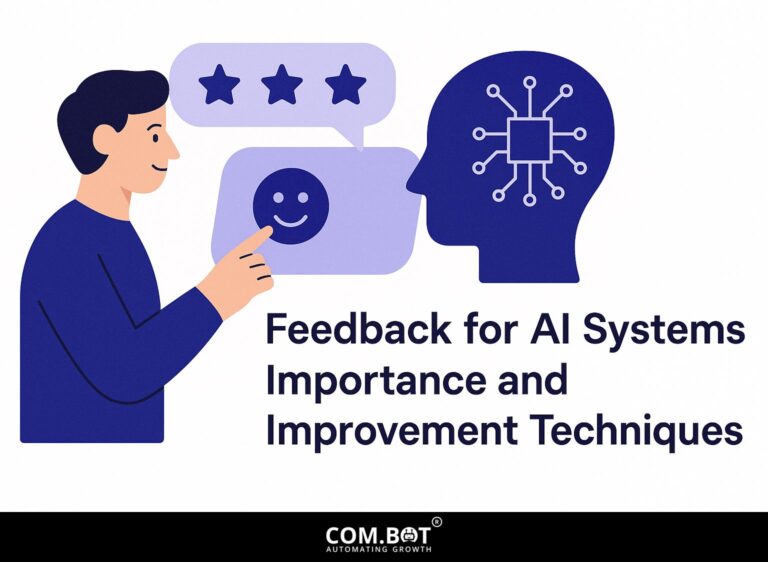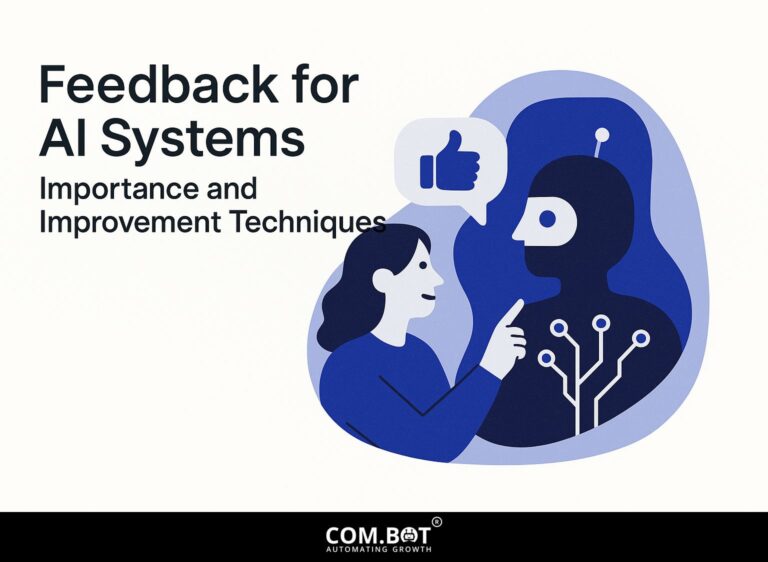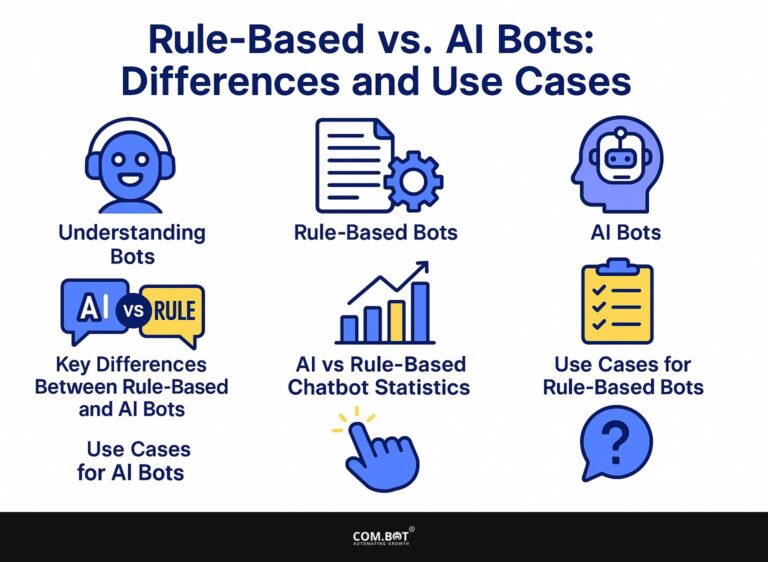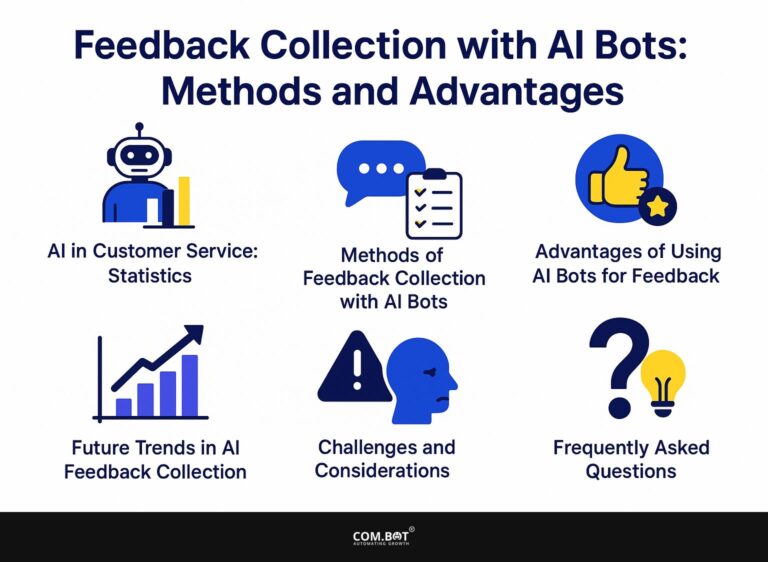Feedback for AI Systems: Importance and Improvement Techniques
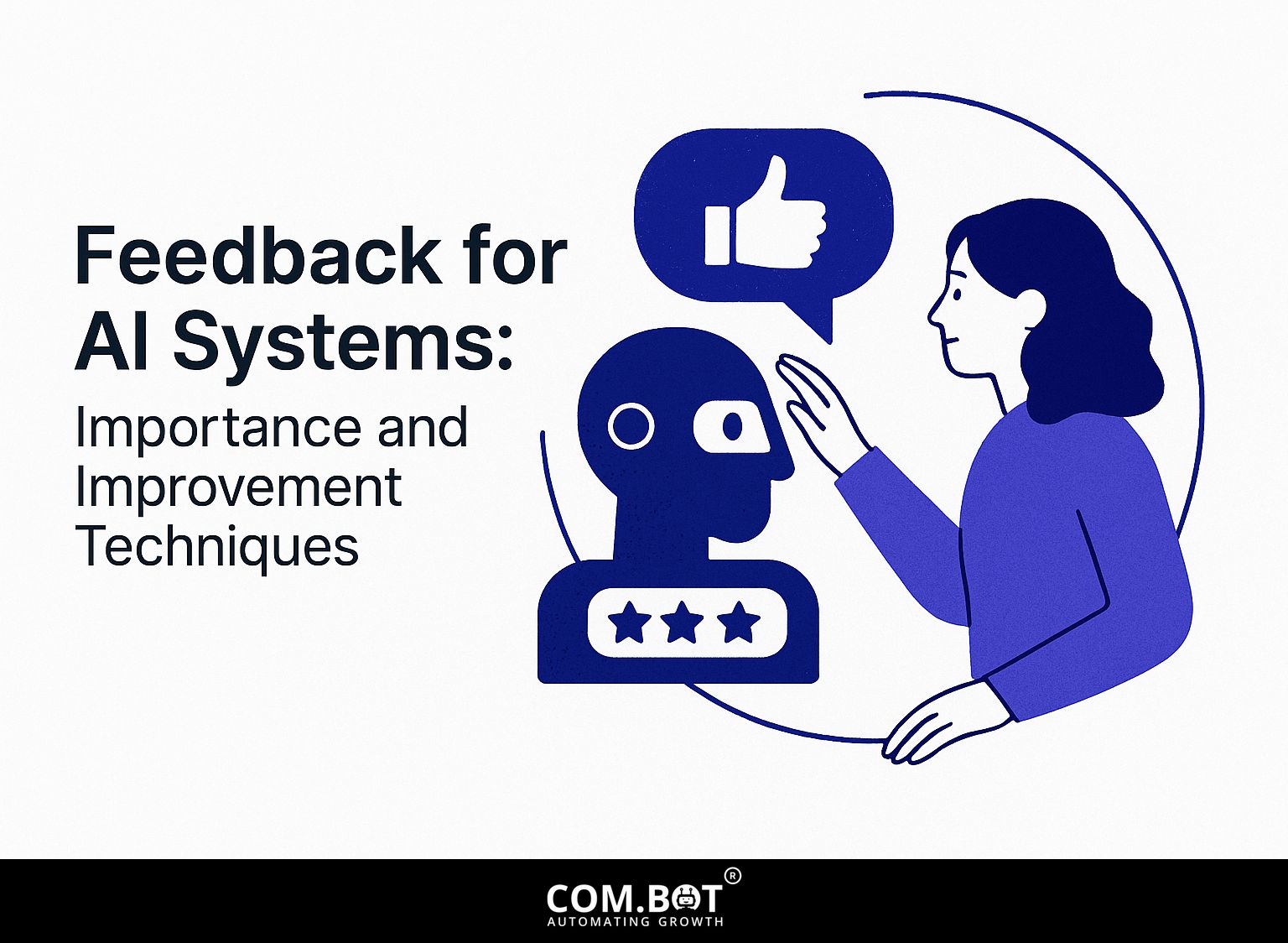
In the fast-changing field of AI, effective feedback loops are essential for improving performance and encouraging new ideas. As artificial intelligence and generative AI keep changing industries, knowing how to effectively use feedback for machine learning systems becomes important. This article examines why feedback is important, looks at ways to make it better, and discusses how it affects the success and ethics of AI systems. Learn how to improve AI performance by gathering and analyzing feedback strategically.
Key Takeaways:
- 1 Importance of Feedback in AI Systems
- 2 AI Feedback Improvement Stats
- 3 Types of Feedback Mechanisms
- 4 Techniques for Collecting Feedback
- 5 Analyzing Feedback Data
- 6 Implementing Feedback for Improvement
- 7 Challenges in Feedback Implementation
- 8 Future Trends in AI Feedback Systems
- 9 Frequently Asked Questions
- 9.1 What is feedback for AI systems and why is it important?
- 9.2 How does feedback benefit AI systems?
- 9.3 What are some techniques for providing feedback to AI systems?
- 9.4 Can AI systems learn from negative feedback?
- 9.5 How can AI systems be improved through feedback?
- 9.6 Why is it important to regularly provide feedback to AI systems?
Definition and Purpose
AI feedback systems work by using loops to improve algorithms with live user input and results.
For example, chatbots improve their responses by analyzing conversations with users. When a user is unhappy, the chatbot records this feedback to improve later conversations.
Tools like Google’s Dialogflow or Rasa enable developers to build chatbots that learn from user interactions by applying NLP techniques. By using these feedback systems, organizations can consistently improve user engagement and satisfaction, making their AI programs more effective and easier to use.
This ongoing process makes responses better and adjusts the chatbot’s actions to fit users’ specific needs over time.
Historical Context
The evolution of AI feedback systems dates back to early machine learning models, which relied heavily on supervised feedback for algorithm adjustments.
In the late 1990s, researchers began implementing techniques like Q-learning, which allowed machines to learn from their actions through trial and error.
The introduction of neural networks further advanced the field, enabling complex patterns to be recognized in large datasets.
The development of deep reinforcement learning in 2013 marked an important moment, highlighted by Google’s DeepMind succeeding in playing video games.
These advancements have led to real-time feedback systems that learn user preferences, such as those used in recommendation engines on platforms like Netflix and YouTube.
Today, AI feedback systems keep improving, using large data sets and computing strength to improve user experiences in many applications.
Importance of Feedback in AI Systems
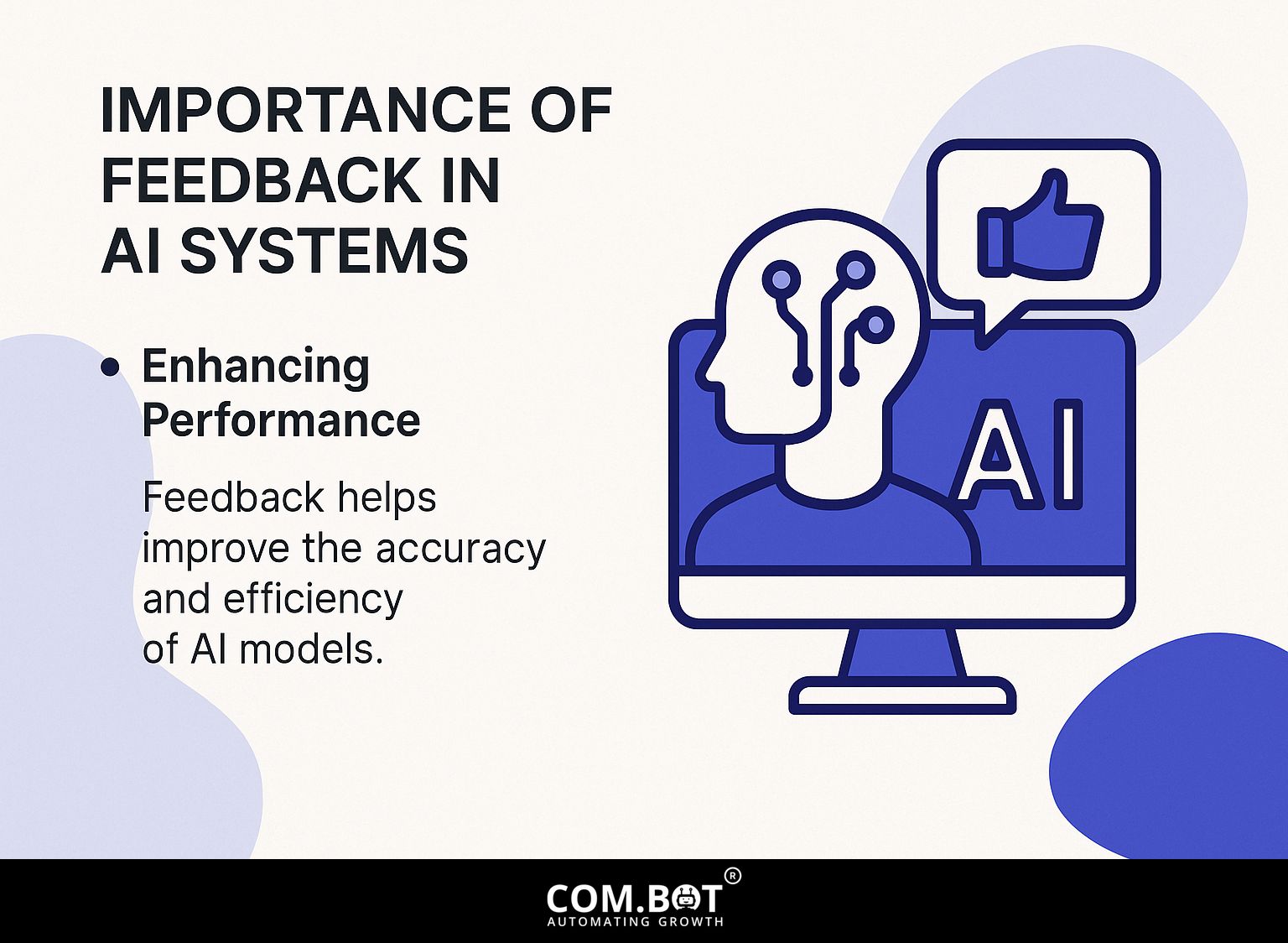
Feedback is important for AI systems because it helps make them work better, keeps users satisfied, and deals with ethical concerns. If you’re interested in exploring how to enhance these benefits, consider the techniques discussed in our comprehensive guide on Feedback for AI Systems.
Enhancing Performance
Using user feedback greatly improves AI performance, with companies seeing efficiency increase by up to 50% through steady improvements.
For example, diagnostic tools in healthcare, such as IBM Watson Health, regularly change their algorithms based on patient results and doctor input.
By examining extensive data collections and learning from user feedback, these systems can become better at making accurate predictions as time goes on.
In a similar way, companies such as Google rely on user feedback to improve their AI-based search systems, resulting in more relevant search results.
Encouraging users to share their experiences and ideas helps create a team atmosphere, which leads to new ideas and makes the system work better.
AI Feedback Improvement Stats
AI Feedback Improvement Stats
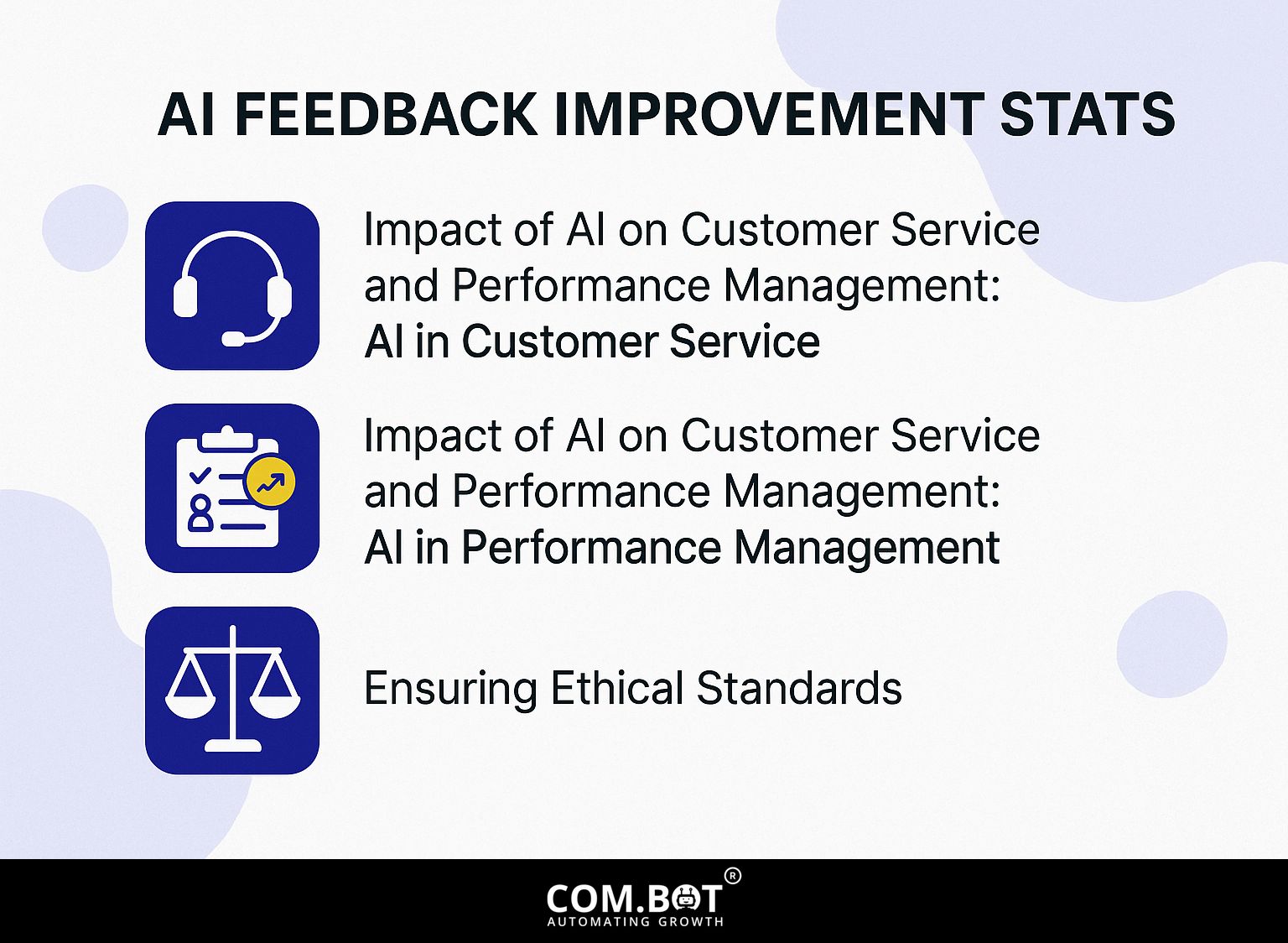
Impact of AI on Customer Service and Performance Management: AI in Customer Service
Impact of AI on Customer Service and Performance Management: AI in Performance Management
The AI Feedback Improvement Stats Look at how Artificial Intelligence (AI) changes customer service and performance management. This information helps understand how well AI works in improving how businesses run and how happy customers are.
AI in Customer Service highlights how AI has become ubiquitous in customer interactions, with a 100% integration rate. This widespread adoption signifies that businesses are increasingly relying on AI to handle customer queries and support tasks. AI agents demonstrate a remarkable 80% resolution rate, showcasing their efficiency in addressing customer issues and reducing the burden on human customer service representatives. This high resolution rate indicates that AI agents are successful in resolving a significant majority of customer concerns, leading to improved efficiency and customer satisfaction.
Regarding AI in Performance Management, 97% of business owners predict benefits from AI, showing strong belief that AI can improve how businesses run and help in making decisions. However, there is also a warning shared by 40% of business owners who worry about relying too much on AI, highlighting the importance of combining AI use with human supervision to prevent problems like decreased human decision-making and flexibility.
- Dissatisfaction with Current Systems: Interestingly, 95% of business managers express dissatisfaction with current systems, suggesting that existing performance management tools are not meeting expectations. This unhappiness creates an opportunity for AI tools to fix problems in current systems by giving more accurate and efficient ways to analyze performance.
The data indicates a strong shift towards AI-driven processes in customer service and performance management, driven by high integration and resolution rates and a perceived potential for improvement. It also shows the importance of managing AI carefully to avoid depending too much on it and to keep human skills essential in business activities.
Ensuring Ethical Standards
Feedback systems are important for maintaining ethical standards in AI development by identifying and reducing biases in training data.
Companies like Google and IBM have implemented structured feedback loops that allow users to report perceived biases in AI outputs.
For example, Google’s AI rules suggest developers get outside reviews and input from users to improve their models.
At IBM, a specific tool called Watson OpenScale integrates direct user input to assess fairness in AI decisions.
By regularly analyzing this feedback, organizations can identify areas where biases may persist and take corrective actions, ensuring that their AI systems operate justly and transparently.
Types of Feedback Mechanisms
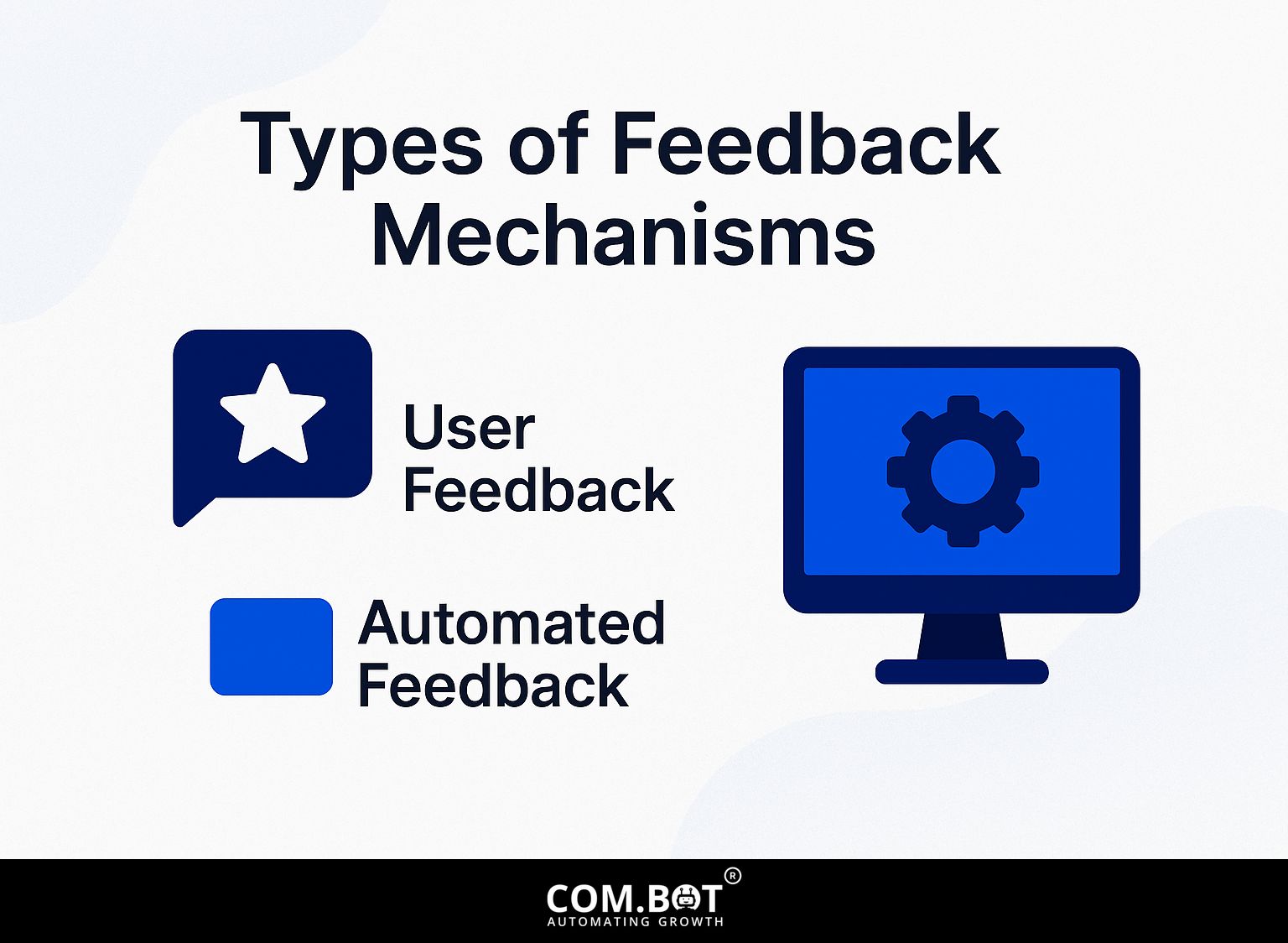
AI feedback systems can be divided into two types: those that involve responses from users and those that provide feedback automatically, each with different functions. For a more comprehensive understanding of these systems, see how various feedback mechanisms impact AI performance and how they can be improved.
User Feedback
Feedback from user surveys and direct talks gives useful information that helps make AI systems better.
To effectively collect user feedback, employ a mix of qualitative and quantitative methods.
Using sentiment analysis tools like MonkeyLearn can help understand user feelings from comments and reviews. Integrating simple rating systems in chatbots allows users to evaluate responses.
To gather numerical data, use tools such as SurveyMonkey to create focused surveys that measure how satisfied users are with certain features.
By combining these methods, you’ll get a full view of how users interact, helping you make better adjustments to AI systems.
Automated Feedback
Automated feedback systems use data tools to monitor AI performance and adjust instantly without needing people.
For example, Amazon uses predictive analytics to evaluate customer actions, allowing its recommendation system to quickly change based on user activity.
Tools like Google Cloud AI and Microsoft Azure Machine Learning provide feedback systems that help developers improve their algorithms using performance data.
Implementing these systems typically involves setting up real-time data pipelines, enabling the AI to learn from live interactions and adjust its outputs accordingly. This approach improves the user experience and makes the AI work better as time goes on.
Techniques for Collecting Feedback
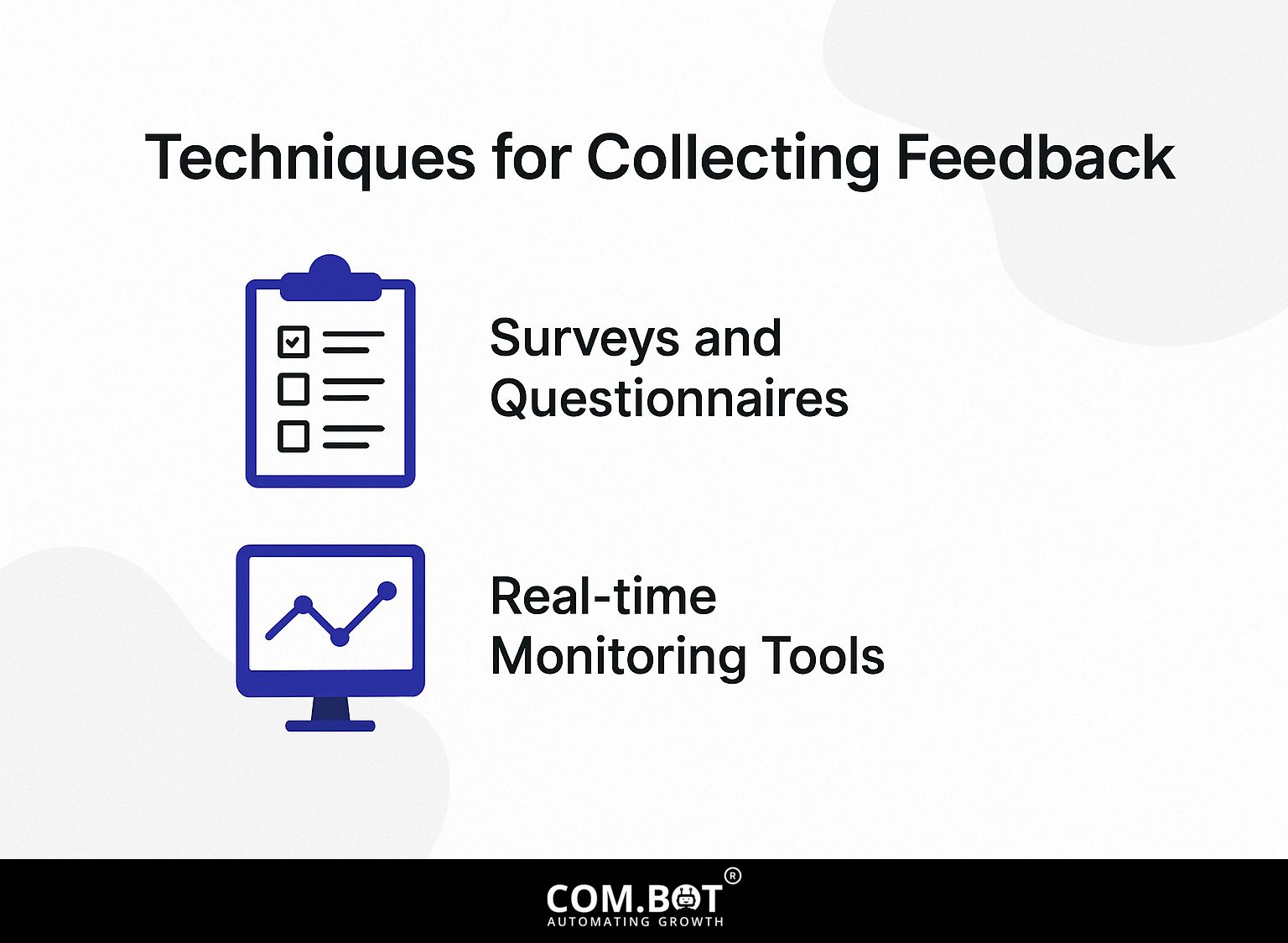
To gather useful information from feedback, use methods like surveys and tools that track actions as they happen. This approach can be particularly beneficial for improving AI systems, as detailed in our guide on AI feedback techniques and their importance.
Surveys and Questionnaires
Surveys and questionnaires are an easy way to gather opinions from users, helping AI systems to modify based on user preferences.
To design effective surveys, start by defining clear objectives. Use tools like Google Forms for its user-friendly interface, or SurveyMonkey for advanced analytics.
Create questions that are neutral. For instance, ask people to rate their satisfaction on a scale from 1 to 5 instead of using questions that suggest an answer. Use open-ended questions to gather detailed, qualitative information.
Distribute your survey through email, social media, or embedded links in your website, ensuring you target the right audience. A well-designed survey can give you useful information, allowing you to improve AI features based on actual user requirements.
Real-time Monitoring Tools
Real-time monitoring tools, such as Splunk and Datadog, capture system performance and user interactions for immediate feedback analysis.
These tools offer detailed dashboards to show important information, like response times and how users behave.
For example, Splunk offers custom alerts when performance dips below a set threshold, while Datadog features anomaly detection to highlight unusual patterns.
Both tools integrate smoothly with other applications, enhancing notification systems and enabling faster decision-making.
Setting up these solutions usually takes some time at the start, but being able to address problems as they happen greatly improves the experience for users and how well operations run.
Analyzing Feedback Data
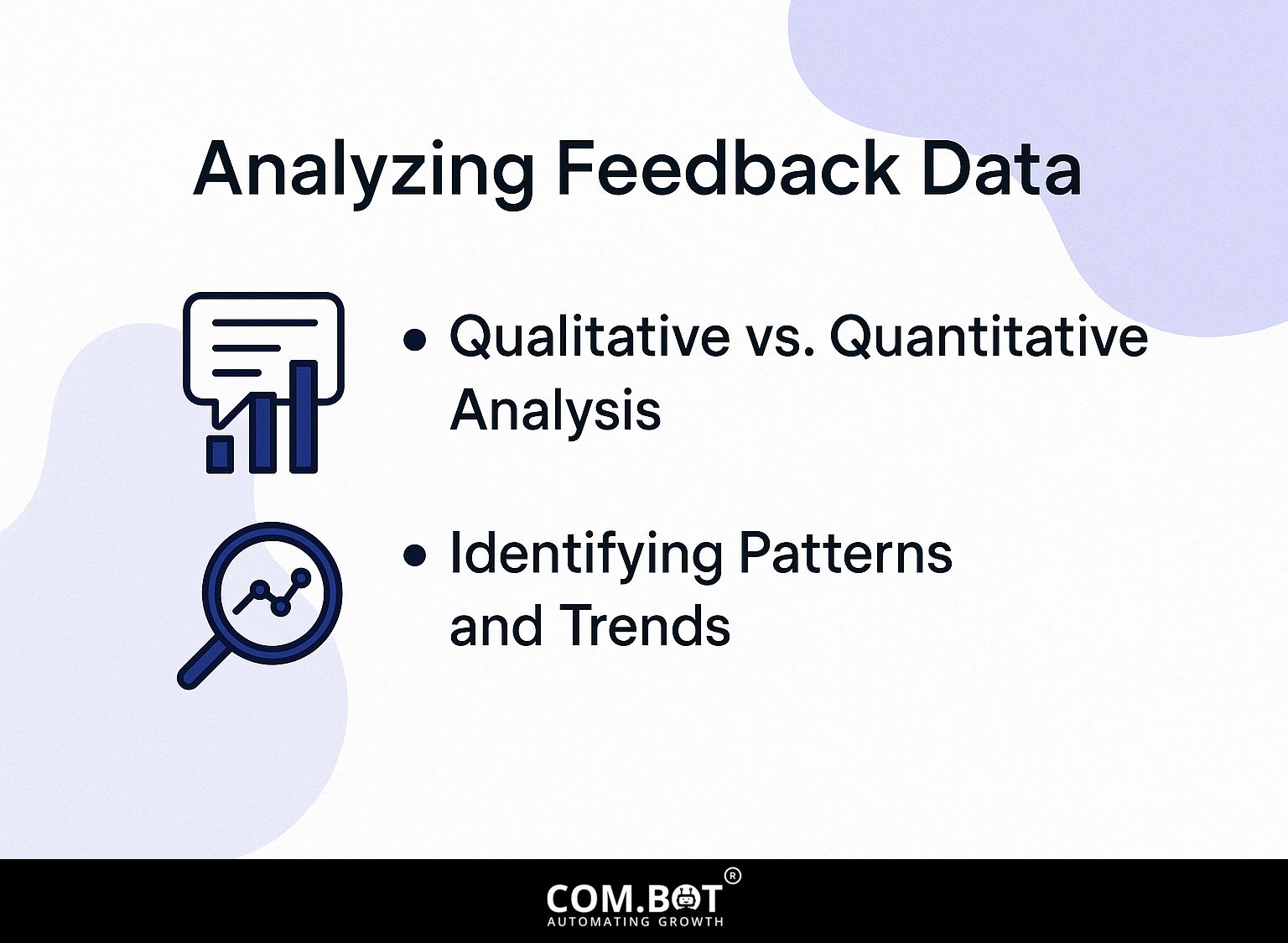
Analyzing feedback involves using both descriptive and numerical methods to get useful information from what users say.
Qualitative vs. Quantitative Analysis
Qualitative analysis focuses on user sentiments, while quantitative analysis employs numerical data to assess AI performance.
To perform qualitative analysis, tools like Sentiment Analyzer and MonkeyLearn can measure user feelings through feedback and reviews.
For quantitative analysis, Google Analytics is essential for measuring user interactions and conversion rates numerically. You might want to consider A/B testing tools like Optimizely, which provide information on user preferences using statistical significance.
By combining these methods, you can fully grasp how AI works by considering both user feedback and detailed outcomes.
Identifying Patterns and Trends
Identifying patterns and trends in feedback data allows AI systems to predict user behavior and improve service delivery.
To properly examine feedback data, companies often use data visualization tools like Tableau and Microsoft Power BI.
For instance, a retail company may use Tableau to visualize customer satisfaction scores over time, revealing a troubling dip during the holiday season. By looking into it more, they might find out that long wait times led to bad feedback.
In response, they implemented a real-time queue tracking system. This improved customer experience and increased sales during busy times, showing how trend analysis provides useful information.
Implementing Feedback for Improvement
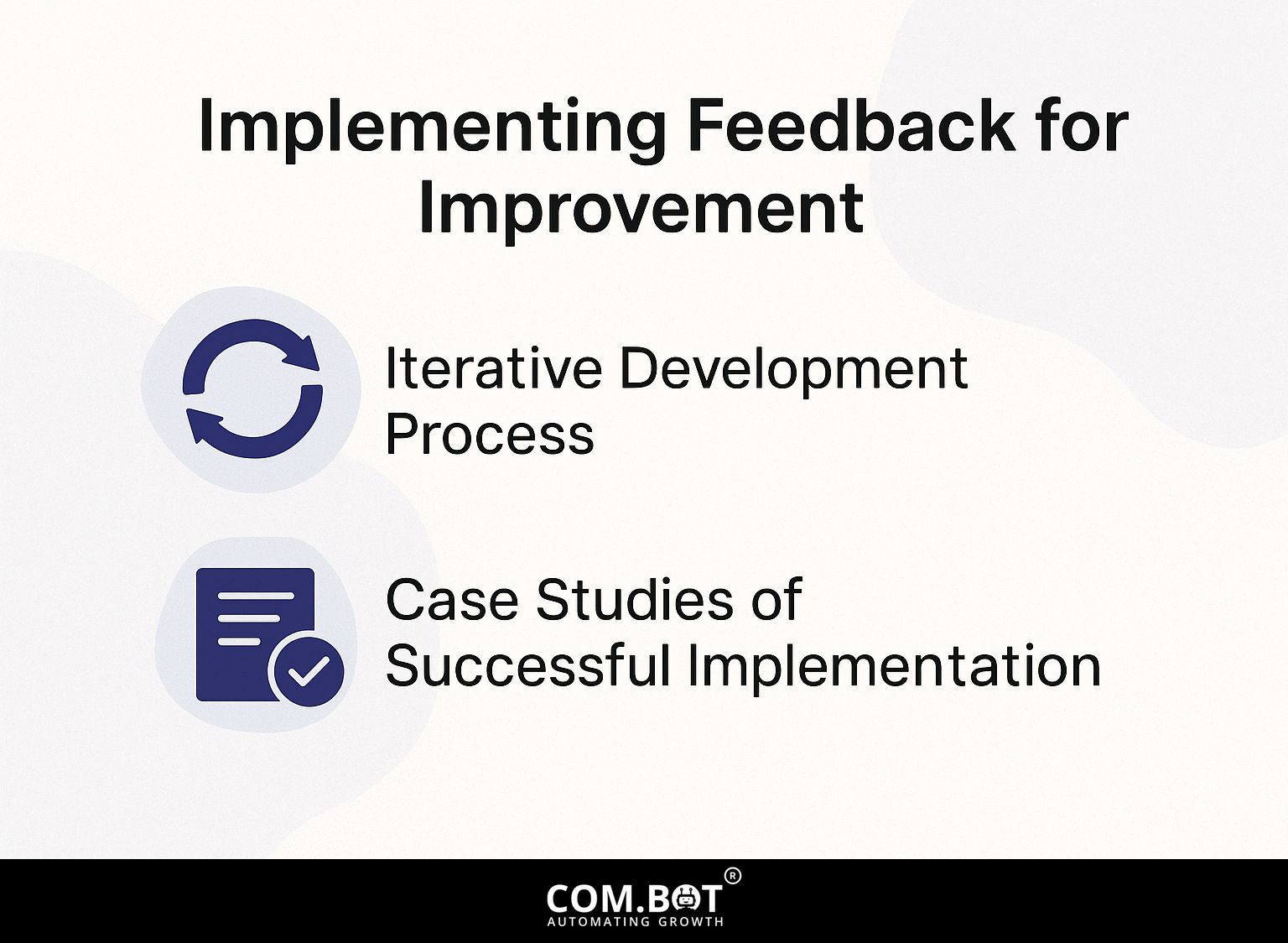
Implementing user feedback is important for AI systems to improve their features and meet changing user needs.
Iterative Development Process
The step-by-step development method allows for ongoing improvements to AI systems using user feedback and performance data.
Methods like Agile and Scrum are great for doing tasks repeatedly and effectively. These methodologies emphasize quick sprints, allowing teams to gather feedback after short development cycles.
Spotify used Agile methods to improve user experience by regularly testing with users. By frequently checking and improving their algorithms, AI systems like chatbots become better at giving correct responses.
This cycle of testing, feedback, and refining speeds up development and makes sure the final product meets user needs.
Case Studies of Successful Implementation
Looking at case studies shows how organizations used feedback loops to improve AI systems and get clear results.
A clear example is Starbucks, which used customer feedback through its My Starbucks Idea platform. This tool allowed customers to submit ideas and vote on them, leading to the introduction of mobile ordering, which increased sales by 11% in one quarter alone.
At Google, feedback from employees was collected through regular surveys and peer reviews, which led to a 20% increase in employee satisfaction and a significant rise in productivity.
These cases highlight the importance of integrating feedback mechanisms into operational strategies for continuous improvement.
Challenges in Feedback Implementation
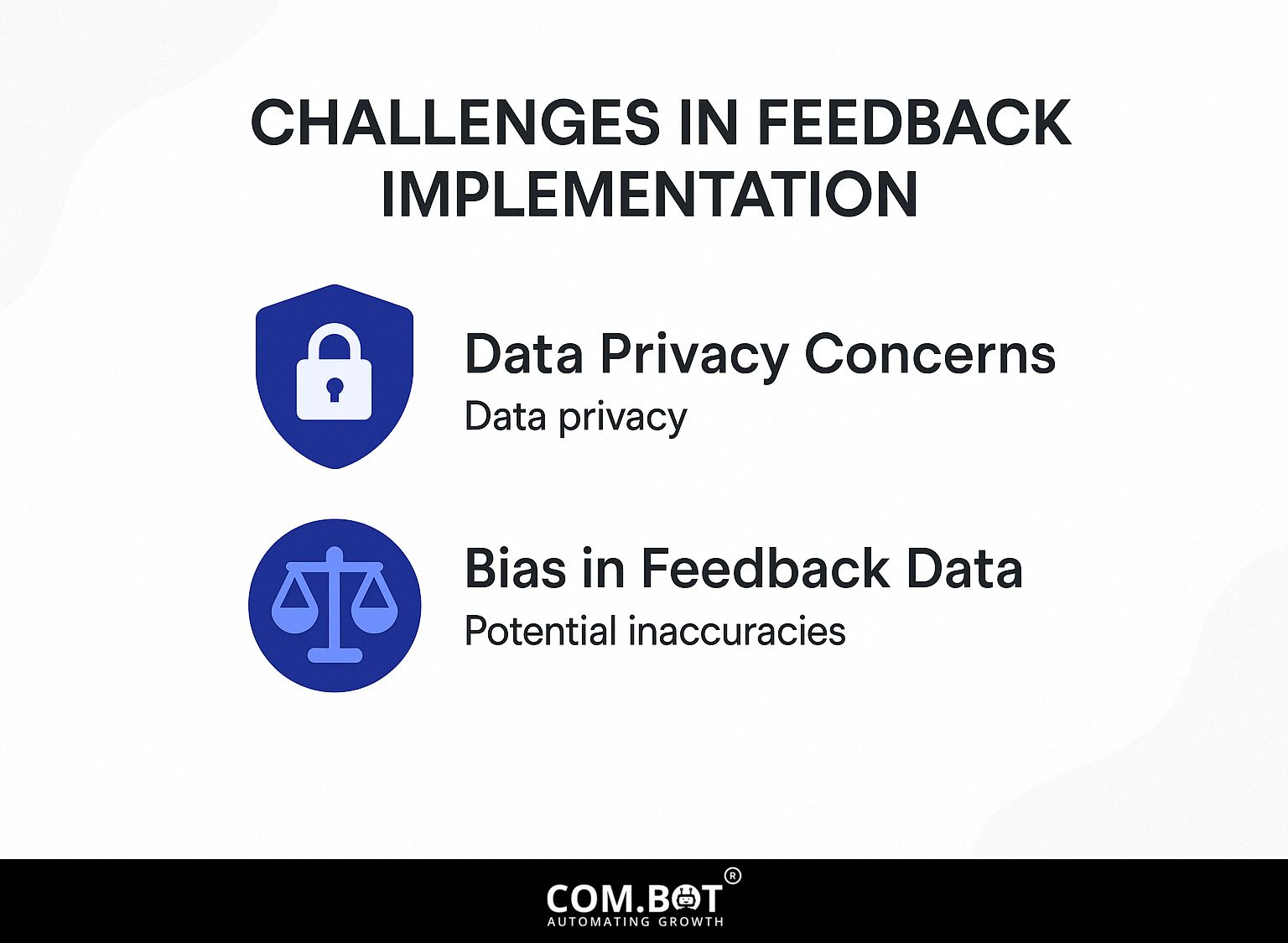
Although important, setting up feedback systems in AI involves many difficulties that organizations need to handle with care. This process aligns with the principles outlined in our analysis of Feedback for AI Systems: Importance and Improvement Techniques, which explores the strategies to enhance feedback mechanisms effectively.
Data Privacy Concerns
Data privacy concerns pose significant challenges in AI feedback systems, potentially undermining user trust if not adequately addressed.
To handle these challenges, organizations should put strong data protection steps in place.
- Begin by removing personal information from feedback data to keep identities private.
- Use safe encryption techniques for storing and sending data, using tools like AES (Advanced Encryption Standard).
- Regularly review data access permissions, allowing only authorized personnel to view sensitive information.
- Being open with users about how their data is used can greatly increase trust.
- Establish a clear, accessible privacy policy, outlining the steps taken to safeguard their information and how it can be removed upon request.
Bias in Feedback Data
Bias in feedback data can affect AI system performance and result in poor decisions, so strong methods to reduce bias are needed.
To detect and mitigate bias, implement methods such as data auditing, using tools like Fairness Indicators or AIF360. Start by collecting feedback data for analysis; this allows you to identify patterns of bias against certain demographic groups.
For example, if a user feedback system shows mostly negative feelings about a minority group, it’s important to know the situation and make changes as needed. Regularly updating AI models with balanced datasets and creating clear feedback methods can improve fairness and accuracy.
Incorporating these strategies will lead to improved AI performance and trustworthiness.
Future Trends in AI Feedback Systems
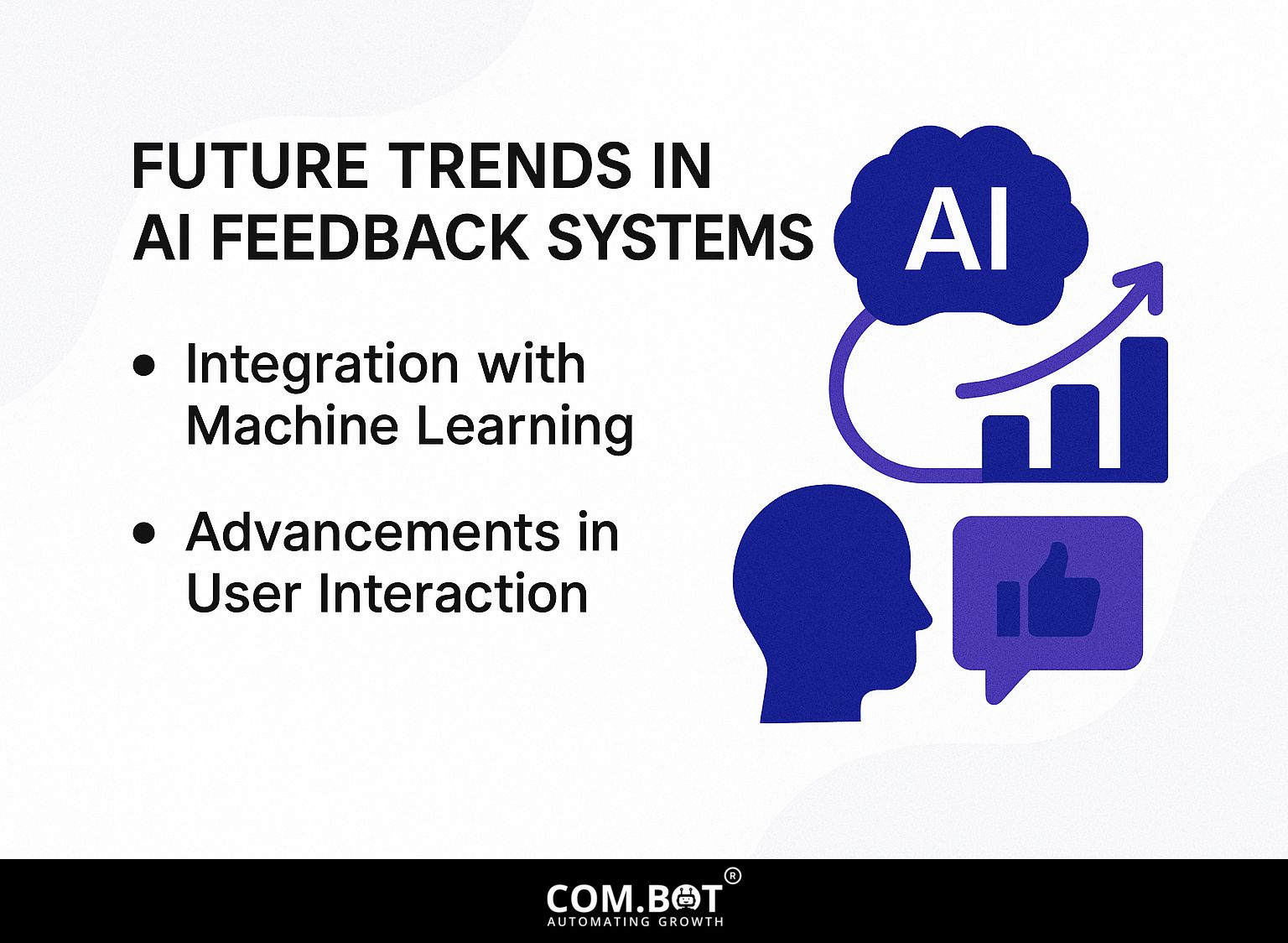
AI feedback systems will change a lot soon, especially with progress in machine learning and how users interact with technology. To better understand these changes, it’s crucial to explore the importance of feedback in AI systems and the techniques for their improvement.
Integration with Machine Learning
Using feedback systems along with machine learning methods makes AI systems more accurate and able to change.
To do this well, start by using tools like TensorFlow or PyTorch that handle data processing quickly and provide immediate feedback.
For instance, utilizing reinforcement learning techniques enables models to learn from previous outputs by adjusting their strategies based on the success or failure of past actions.
Employing survey tools such as Google Forms or Typeform can gather user feedback, which is then used to fine-tune model parameters.
This loop of feedback and changes leads to a constantly better system, keeping the AI useful and working well in changing situations.
Advancements in User Interaction
New developments in user interaction technologies are changing the way feedback is gathered and used in AI systems.
For instance, voice recognition enables users to provide feedback hands-free, which is especially useful in mobile apps. Technologies like Google Speech-to-Text or Amazon Transcribe convert spoken input into text, facilitating immediate user reviews.
Natural language processing (NLP) examines the feelings expressed in user comments, helping AI to measure how satisfied users are with greater accuracy. Companies like Drift use chatbots with natural language processing to talk with users right away, gathering details from regular conversations.
This method makes it easier to collect feedback and increases user involvement by using personalized interactions.
Frequently Asked Questions
What is feedback for AI systems and why is it important?
Feedback for AI systems means giving information to a machine learning system about how well it is doing and what outcomes it produces. This is important because it helps the system improve its accuracy and usefulness.
How does feedback benefit AI systems?
Feedback gives important information to AI systems on how to get better and handle different situations. This helps them make better predictions, suggestions, and decisions later on.
What are some techniques for providing feedback to AI systems?
There are various techniques for providing feedback to AI systems, including annotation, labeling, tagging, and rating. These techniques involve manually providing labels or scores to data inputs, which the system can then use to adjust its algorithms and improve its performance.
Can AI systems learn from negative feedback?
Yes, AI systems can learn from negative feedback just as they can from positive feedback. Negative feedback can show where things need to be improved and stop the system from repeating past errors.
How can AI systems be improved through feedback?
AI systems can be improved through feedback by using machine learning techniques to analyze the feedback data and adjust the system’s algorithms and parameters. This process, called “training,” lets the system keep getting better and handle various situations.
Why is it important to regularly provide feedback to AI systems?
Regular feedback is important for AI systems because it allows them to continuously learn and improve their performance. Without regular feedback, the system may become outdated and less effective in its tasks.

